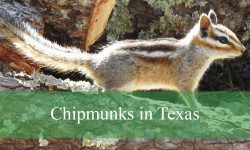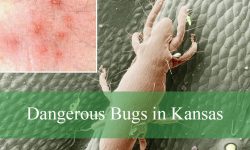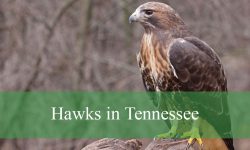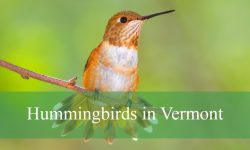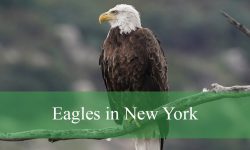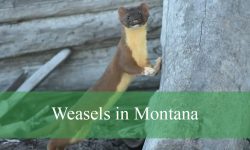California hosts an incredible diversity of black birds with long beaks, each uniquely adapted to its environment. These birds use their long bills for various purposes, such as probing mud for invertebrates, skimming fish from the water’s surface, or cracking seeds and fruits. Their striking appearance and specialized feeding behaviors make them fascinating to observe.
Across the state, these birds inhabit a wide range of ecosystems, from rocky coastal cliffs and tidal mudflats to freshwater lakes, open grasslands, and even urban parks. Species like the Black Oystercatcher and Black Skimmer are closely associated with the coastline, while the Common Raven and Great-tailed Grackle are common in agricultural fields and city landscapes.
This article introduces 20 black birds with long beaks in California along with pictures and detailed descriptions. Learning about their identification, habitat, and habits offers a deeper appreciation for California’s rich birdlife.
Types of Black Birds with Long Beaks in California
Black Oystercatcher (Haematopus bachmani)
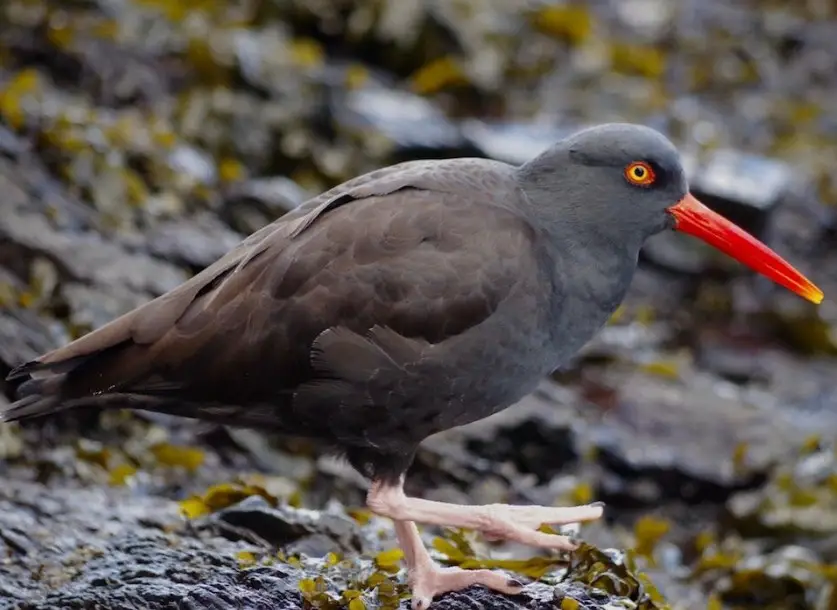
The Black Oystercatcher is a striking shorebird with entirely black plumage and a long, bright orange-red bill. Its body is sturdy and compact, with strong pinkish legs, making it easy to spot against the rocky California coastline. Adults typically measure about 15 to 17 inches in length with a wingspan reaching up to 28 inches, making them one of the more robust shorebirds along the Pacific coast.
This bird is best recognized by its loud, high-pitched whistling calls and its habit of staying close to intertidal zones. Its long, strong bill is specially adapted for prying open mussels, limpets, and other shellfish, which form the bulk of its diet. Black Oystercatchers are also very territorial, often chasing away intruders from their feeding and nesting areas.
In California, they are found year-round along rocky shorelines and islands, especially in areas with plentiful tide pools. They nest in shallow scrapes on rocks, where they blend perfectly with their surroundings. Conservation efforts protect these birds as they are considered indicators of healthy intertidal ecosystems.
Black Skimmer (Rynchops niger)
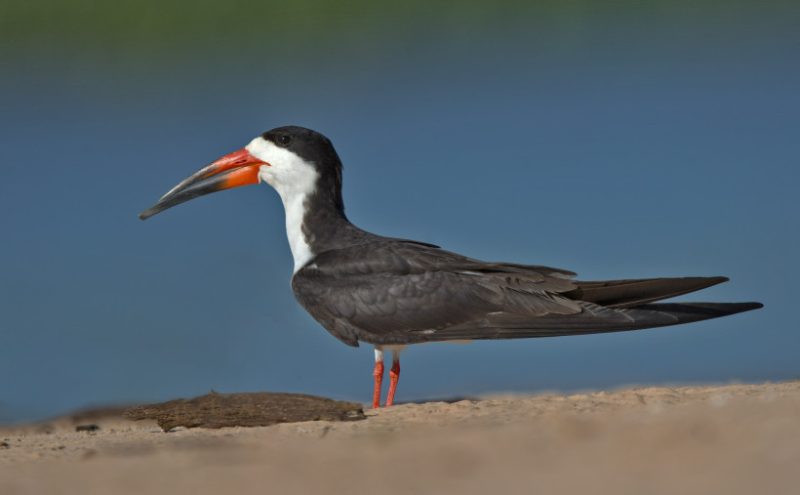
The Black Skimmer is a unique black-and-white coastal bird with a long, laterally compressed bill that is orange at the base and black at the tip. What makes it stand out is its uneven bill structure: the lower mandible is significantly longer than the upper, allowing it to skim the water surface. Adults average 16 to 20 inches long with an impressive wingspan that can exceed 44 inches, giving them an elegant, gliding flight.
Black Skimmers are social birds, often seen flying low over calm waters in flocks, with their long lower mandibles cutting through the water to catch fish. They are mostly silent in flight but may emit sharp barking-like calls when gathered in colonies. Their foraging behavior is most active during dusk and dawn, when fish swim closer to the surface.
In California, Black Skimmers are more common in Southern coastal lagoons, estuaries, and sandy beaches. They nest in colonies on sandy or gravelly shores, where they create shallow scrapes in open areas. Their presence is seasonal, with higher sightings in late spring through summer.
Long-billed Curlew (Numenius americanus)
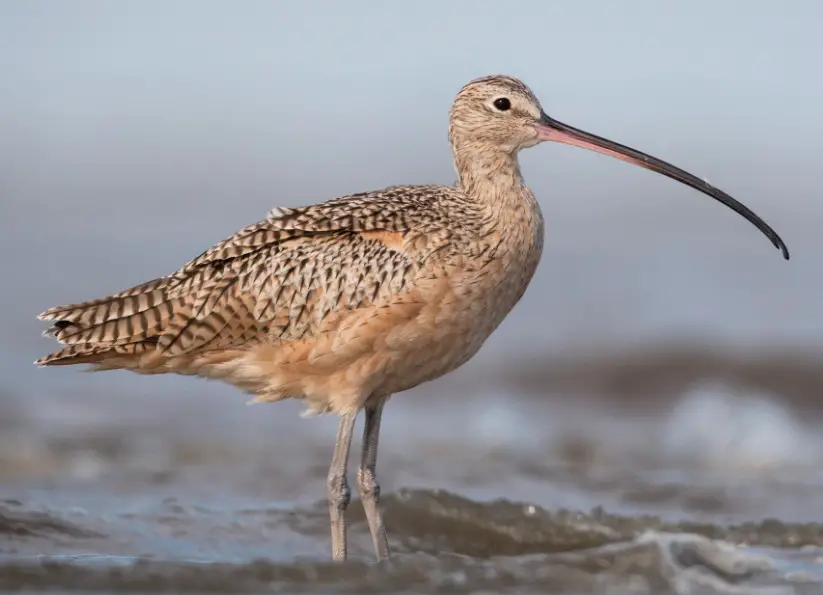
The Long-billed Curlew is the largest North American shorebird, instantly recognized by its extraordinarily long, downward-curved bill. Its plumage is mottled brown with cinnamon underwings, helping it blend into dry grasslands and mudflats. Adults typically measure 19 to 26 inches long, with bills that can reach up to 8 inches in females, making them appear very distinctive among wading birds.
This species uses its long bill to probe deep into mud or soft soil for crabs, worms, and other invertebrates. It is generally quiet but may produce soft, musical whistles during flight. Long-billed Curlews often forage in loose groups, gracefully striding across wetlands or open fields while searching for food.
In California, they are common winter visitors, especially in coastal marshes, estuaries, and inland agricultural fields. Although they breed primarily in grasslands of the western United States, large flocks migrate to California each winter, where they are easily spotted along tidal flats.
Whimbrel (Numenius phaeopus)
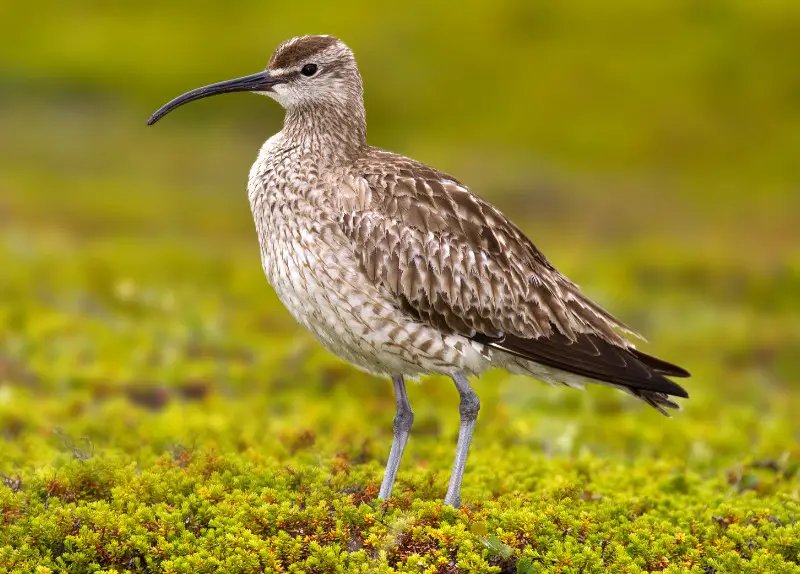
The Whimbrel is a medium-sized shorebird with mottled brown plumage and a long, decurved bill, though shorter than that of the Long-billed Curlew. A key identification feature is the distinctive dark crown stripes contrasting with a pale central stripe on its head. Adults typically range from 15 to 17 inches in length with a wingspan around 31 inches, giving them a graceful but compact appearance.
This bird feeds by probing sand and mud for crabs, mollusks, and marine worms, using its bill to extract prey from deep burrows. It often moves in small flocks and produces sharp, rippling whistles, especially during migration. Whimbrels are also known for their long migratory journeys, traveling thousands of miles between breeding and wintering grounds.
In California, Whimbrels are most often seen during spring and fall migration along coastal estuaries, tidal flats, and salt marshes. A few may linger through winter in sheltered bays and mudflats, sharing feeding areas with other waders.
Black Turnstone (Arenaria melanocephala)
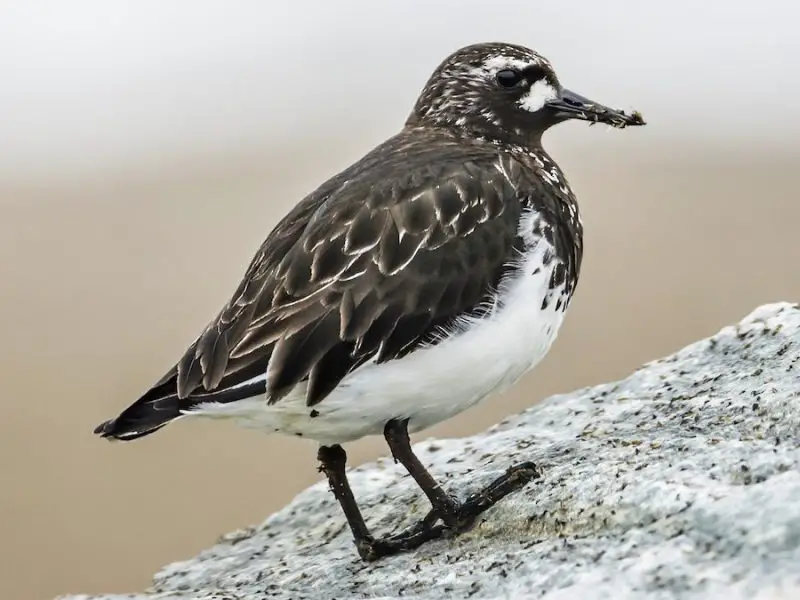
The Black Turnstone is a small, stocky shorebird with mostly dark brownish-black plumage, white underparts, and a short, dark bill. Adults measure about 9 to 10 inches in length, with a wingspan around 20 inches. Their strong legs and sturdy build help them navigate rocky coastlines where they search for food.
This species is named for its feeding behavior—using its short, chisel-like bill to turn over stones, seaweed, and other debris in search of insects, crustaceans, and mollusks. Black Turnstones are highly active, constantly moving along rocks and boulders, often in small, tight flocks. Their calls are sharp and high-pitched, especially when alarmed.
In California, Black Turnstones are winter visitors, particularly along rocky shorelines and jetties. They are common in coastal areas from fall through early spring, where they share intertidal zones with oystercatchers and other shorebirds. Their preference for rugged coastal habitats makes them a favorite among birdwatchers.
Marbled Godwit (Limosa fedoa)
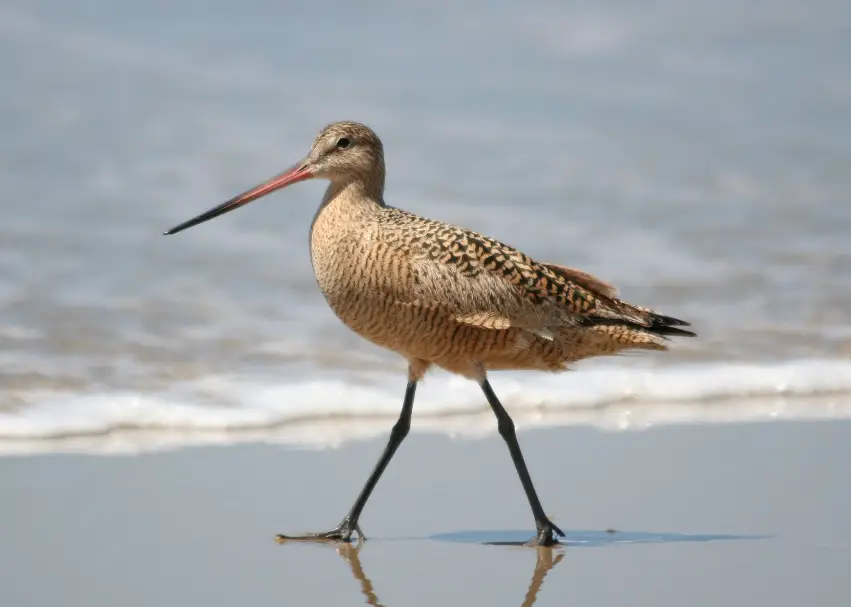
The Marbled Godwit is a tall, elegant shorebird with mottled brown plumage and long bluish-gray legs. Its bill is long, slightly upturned, and bicolored—pinkish-red at the base and black at the tip. Adults typically measure 16 to 19 inches long, with a wingspan of about 28 inches, making them one of the larger waders along California’s coastline.
This species uses its long bill to probe deeply into mud and sand for aquatic invertebrates, primarily worms and crustaceans. Marbled Godwits are active feeders, often seen wading in shallow water while sweeping their bills side to side. Their soft, melodious calls are sometimes heard when they move in flocks during migration.
In California, Marbled Godwits are commonly seen in tidal mudflats, estuaries, and salt marshes, particularly in winter. Large numbers gather along San Francisco Bay and other coastal wetlands, creating a striking sight when they move together in synchronized flocks.
Black Storm-Petrel (Hydrobates melania)
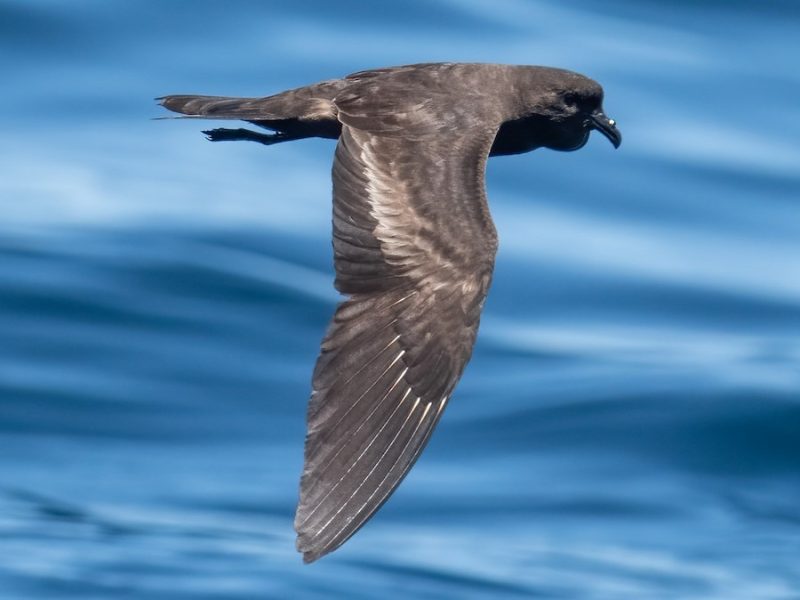
The Black Storm-Petrel is a small, entirely dark seabird with long, narrow wings and a slightly forked tail. Its plumage is blackish-brown, and its small but slender bill is well adapted for catching tiny prey on the ocean’s surface. Adults range from 7 to 9 inches in length, with a wingspan of about 18 inches, making them agile fliers over open water.
This species feeds mainly on planktonic crustaceans and small fish, using a fluttering flight style combined with pattering feet on the water surface to pick up food. Black Storm-Petrels are mostly silent at sea, but their burrow-nesting colonies produce soft, chattering calls at night.
In California, they are often seen offshore, especially around the Channel Islands and coastal waters in Southern California. They spend most of their life at sea and only come to land for breeding, making them a special sight for pelagic birdwatchers.
Black Swift (Cypseloides niger)
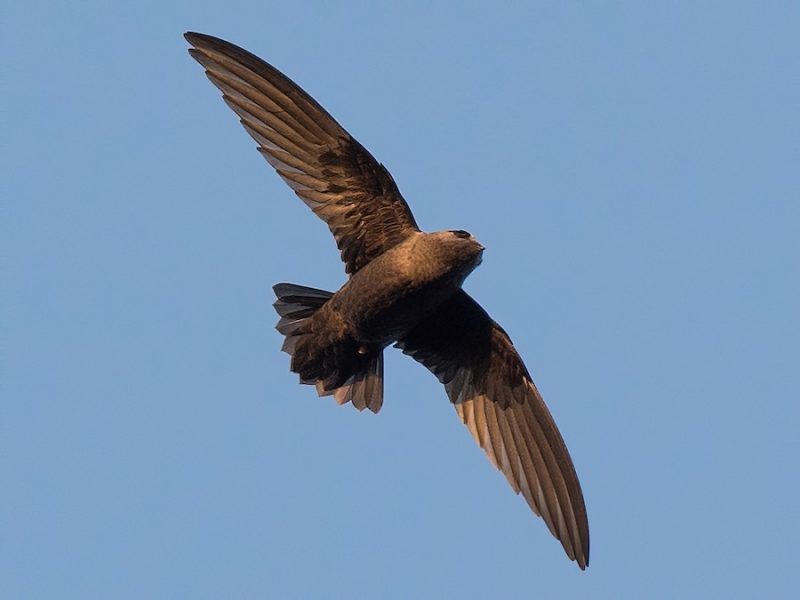
The Black Swift is a sleek, sooty-black bird with long, slender wings and a short, slightly forked tail. Its bill is tiny but elongated, perfectly suited for catching insects in flight. Measuring about 7 inches long with a wingspan of 15 to 17 inches, it is built for fast, powerful flight.
This species is almost exclusively aerial, spending much of its life on the wing. Black Swifts feed on flying insects, capturing them high in the air. Their high-pitched, twittering calls are often heard when they fly in small flocks. These birds are elusive, rarely seen perched, adding to their mysterious reputation.
In California, Black Swifts breed in moist, cliffside habitats, often near waterfalls or steep rock faces. They are more frequently observed in mountainous regions, including areas near Yosemite and the Sierra Nevada, during the breeding season.
American Coot (Fulica americana)
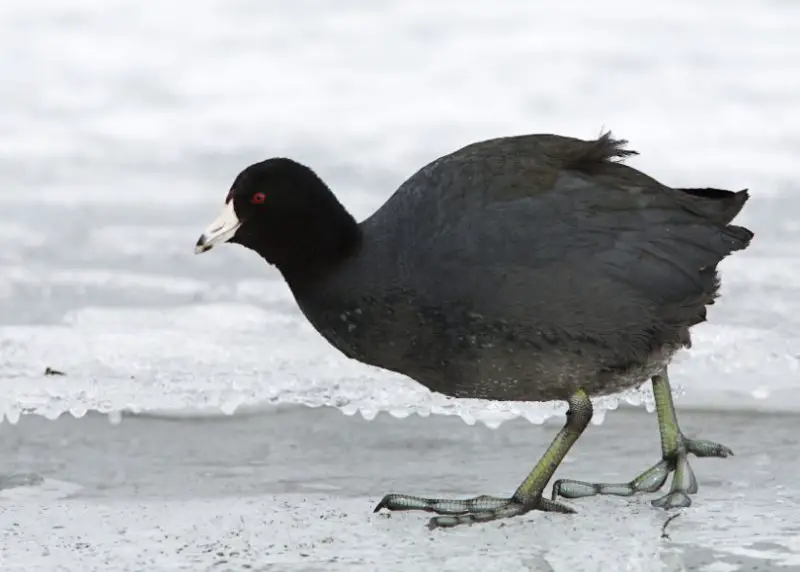
The American Coot is a dark grayish-black waterbird with a distinctive white bill and a small white frontal shield. Its body is plump, with short wings and strong legs adapted for swimming and walking on land. Adults measure about 13 to 16 inches long, with a wingspan of 23 to 25 inches.
Coots are omnivorous, feeding mainly on aquatic vegetation, but they also eat insects, snails, and small fish. Unlike ducks, they lack webbed feet, instead having lobed toes that help them paddle efficiently. Their calls are a series of clucks and grunts, often heard in large, noisy flocks.
In California, American Coots are widespread in lakes, ponds, and marshes year-round. They are particularly abundant in the Central Valley and coastal wetlands, where they form large rafts during migration and winter.
Common Raven (Corvus corax)
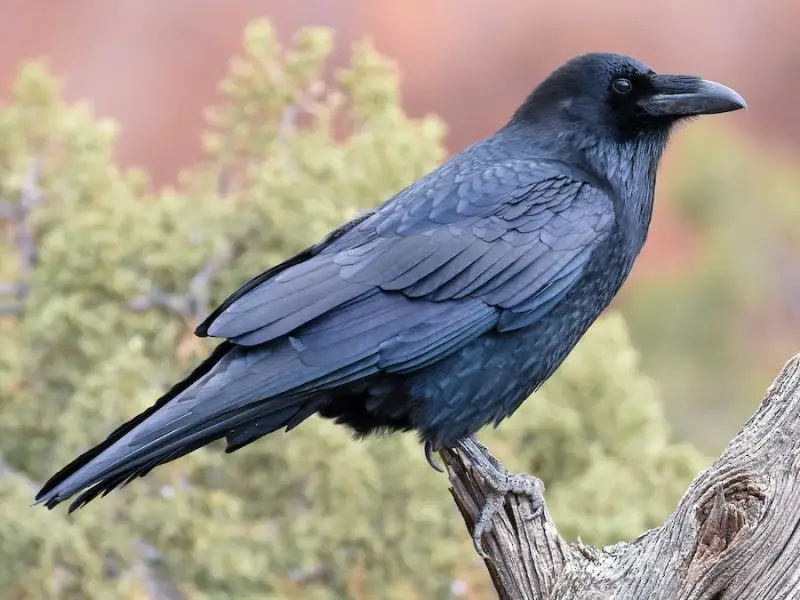
The Common Raven is a large, entirely black bird with a thick, slightly curved bill and shaggy throat feathers. It is the largest songbird in North America, measuring 22 to 27 inches long with a wingspan of 46 to 54 inches. Its glossy black plumage often shows bluish or purplish iridescence in sunlight.
Highly intelligent, ravens are opportunistic feeders, consuming carrion, small animals, fruits, and even human leftovers. Their deep, resonant croaks and a wide variety of vocalizations make them one of the most vocal birds in California. Ravens are known for their playful behavior, including aerial acrobatics and tool use.
In California, they inhabit diverse habitats, from mountain forests to deserts and urban areas. They are especially common in the Sierra Nevada, Mojave Desert, and even coastal cities, where they scavenge in open fields and parking lots.
Great-tailed Grackle (Quiscalus mexicanus)
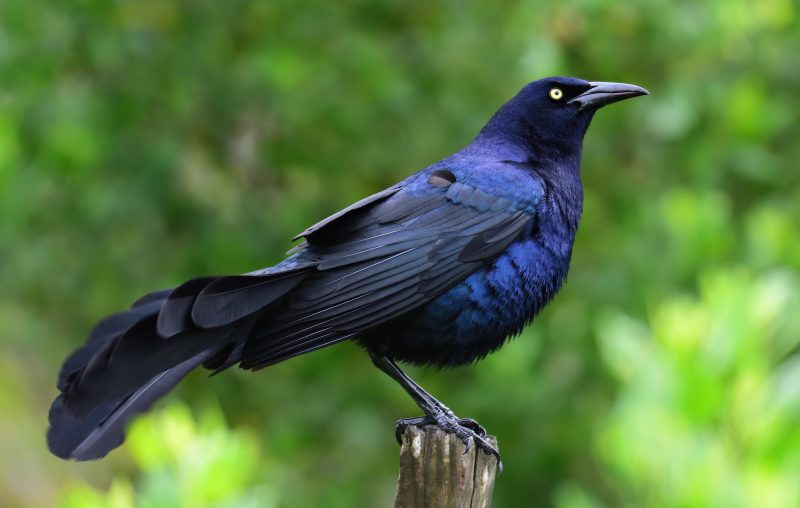
The Great-tailed Grackle is a glossy black bird with an iridescent sheen of blue or purple, especially noticeable in males. It has a long, keel-shaped tail and a sturdy, slightly curved black bill. Adult males are significantly larger than females, measuring 16 to 18 inches long with a wingspan of up to 24 inches, while females are brownish and smaller.
This species is known for its bold and social behavior, often forming large flocks in open areas. Great-tailed Grackles have a wide range of vocalizations, including whistles, squawks, and clicks, making them one of the noisiest urban birds. They forage on the ground or in shallow water, feeding on insects, grains, fruits, and occasionally small vertebrates.
In California, Great-tailed Grackles are most commonly found in Southern regions, especially in wetlands, agricultural fields, city parks, and suburban areas. They thrive in human-altered landscapes, often gathering in parking lots and around food sources.
Brewer’s Blackbird (Euphagus cyanocephalus)
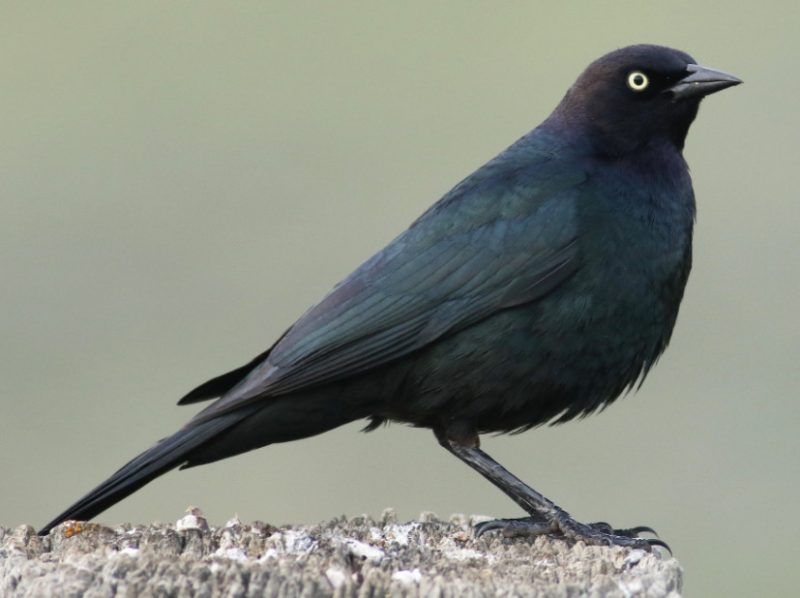
Brewer’s Blackbird is a medium-sized songbird with glossy black plumage in males, while females are dull brownish-gray. The males have bright yellow eyes, contrasting sharply with their dark feathers, and their long, slender bill is perfectly adapted for probing and picking up seeds and insects. Adults average 8 to 10 inches long, with a wingspan around 15 inches.
These birds are highly adaptable and are often seen walking or hopping along the ground in search of food. Their diet consists of grains, seeds, insects, and crumbs found in urban areas. Brewer’s Blackbirds are social, forming flocks during non-breeding seasons, and their calls include sharp “chuk” notes and whistling songs.
In California, they are widespread in open habitats such as grasslands, agricultural fields, and city parks. They are a familiar sight in parking lots, picnic areas, and farmlands, thriving in both rural and urban environments.
Yellow-billed Magpie (Pica nuttalli)
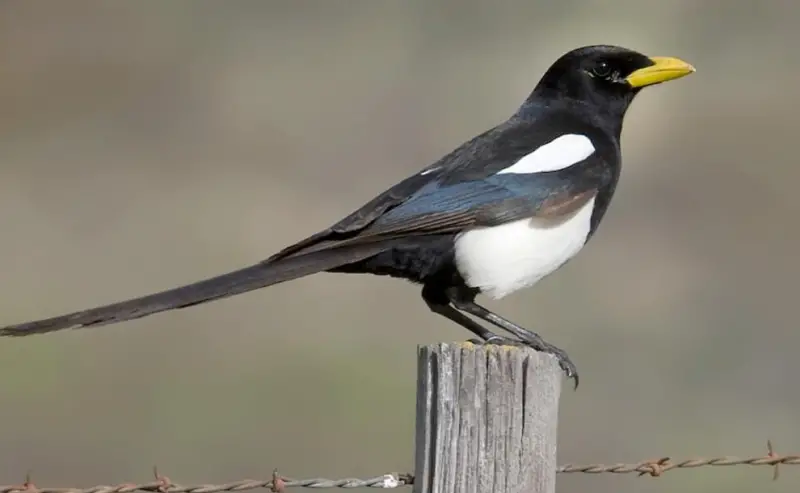
The Yellow-billed Magpie is an eye-catching black-and-white bird with a long tail and a bright yellow bill, making it easy to identify. Its glossy black head and wings contrast with white shoulder patches and underparts. Adults measure about 16 to 18 inches long, with long tails that add to their striking appearance.
This species is highly social and intelligent, often forming noisy flocks in open woodlands and farmlands. They feed on insects, small animals, fruits, and occasionally carrion. Yellow-billed Magpies are known for their chattering calls and playful behavior, which includes hopping, chasing, and occasionally stealing food.
Endemic to California, this bird is found mainly in oak savannas, grasslands, and agricultural regions of the Central Valley. Its population has declined in some areas due to habitat loss, but it remains a characteristic species of California’s interior valleys.
European Starling (Sturnus vulgaris)
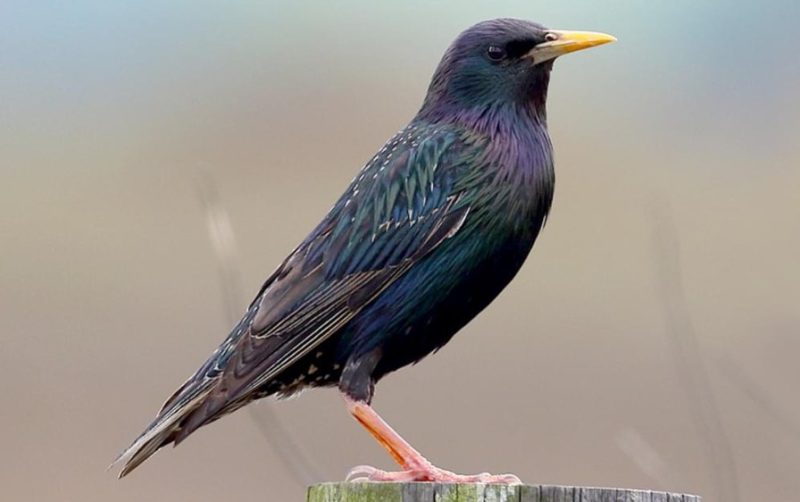
The European Starling is a medium-sized bird with glossy black plumage that shines with purple and green iridescence under sunlight. During the breeding season, adults develop a bright yellow bill, which contrasts with their dark body. Starlings are about 8 inches long, with a wingspan of 12 to 16 inches.
Highly social, starlings often gather in large flocks, especially in winter, creating impressive murmurations in the sky. They feed on insects, fruits, and seeds, often foraging on the ground or probing into soil with their strong bills. Their vocalizations are varied, including whistles, clicks, and imitations of other birds.
In California, European Starlings are common in cities, farmland, and open countryside. They thrive in human-dominated landscapes, nesting in cavities of buildings, trees, and even streetlights. Despite being non-native, they have successfully established large populations across the state.
Brown-headed Cowbird (Molothrus ater)
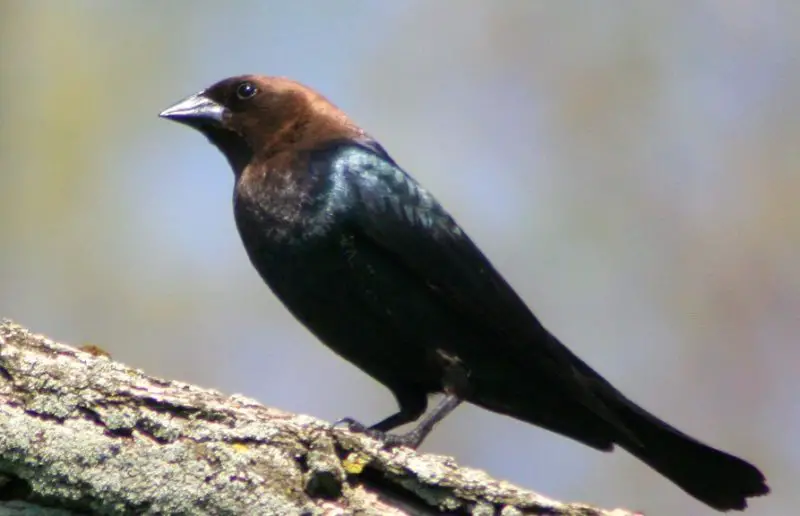
The Brown-headed Cowbird is a stocky blackbird with a distinctive brown head in males, while females are plain brown. Males have glossy black plumage with a slightly conical black bill, suited for eating seeds and insects. Adults are about 7 to 8 inches long, with a wingspan of around 12 inches.
Unlike most birds, cowbirds are brood parasites, laying their eggs in the nests of other bird species. They often perch in open fields or on fences, watching for potential host nests. Their song is a series of bubbly gurgling notes, and they often gather in small flocks outside of the breeding season.
In California, Brown-headed Cowbirds are widespread in grasslands, agricultural fields, and suburban areas. They are frequently seen in the Central Valley and open woodlands, where they benefit from livestock grazing areas and farmland.
Black-headed Grosbeak (Pheucticus melanocephalus)
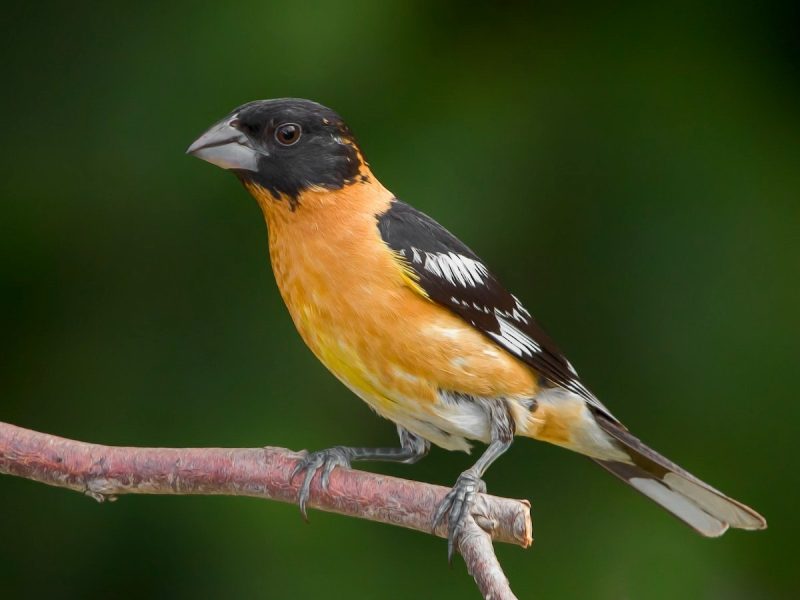
The Black-headed Grosbeak is a striking songbird with a black head, orange-brown breast, and white wing patches in males, while females have streaked brown plumage with a lighter throat. Its thick, conical bill is long and strong, ideal for cracking seeds and eating insects. Adults average 7 to 8 inches long, with a wingspan of about 12 inches.
This species has a melodious, robin-like song and is often heard singing from treetops during the breeding season. Black-headed Grosbeaks feed on insects, berries, and seeds, and they are known for consuming monarch butterflies, which most birds avoid due to toxicity. They are often seen hopping among branches or foraging in dense shrubs.
In California, they are primarily summer visitors, breeding in riparian woodlands, mixed forests, and suburban gardens. They are especially common in the Sierra Nevada foothills and along river valleys before migrating south for the winter.
California Condor (Gymnogyps californianus)
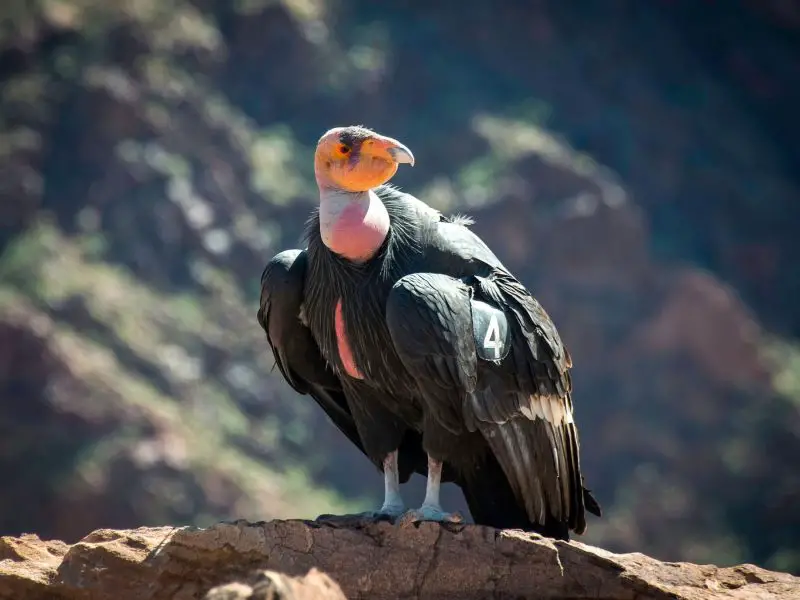
The California Condor is a massive, critically endangered vulture with mostly black plumage and striking white patches under its wings. Its head is bald and ranges in color from yellow to orange, while its large, hooked bill is long and powerful, designed for tearing carrion. Adults can reach 46 inches in length with a wingspan exceeding 9 feet, making it the largest flying bird in North America.
These scavengers feed exclusively on carrion, including large mammals and marine carcasses. They are mostly silent but may produce hisses or grunts when feeding. California Condors are strong gliders, soaring high for hours while searching for food.
In California, they inhabit mountainous regions such as the Big Sur coast, Pinnacles National Park, and the Transverse Ranges. Conservation programs have successfully reintroduced them into the wild, but their population remains carefully monitored.
Anhinga (Anhinga anhinga)
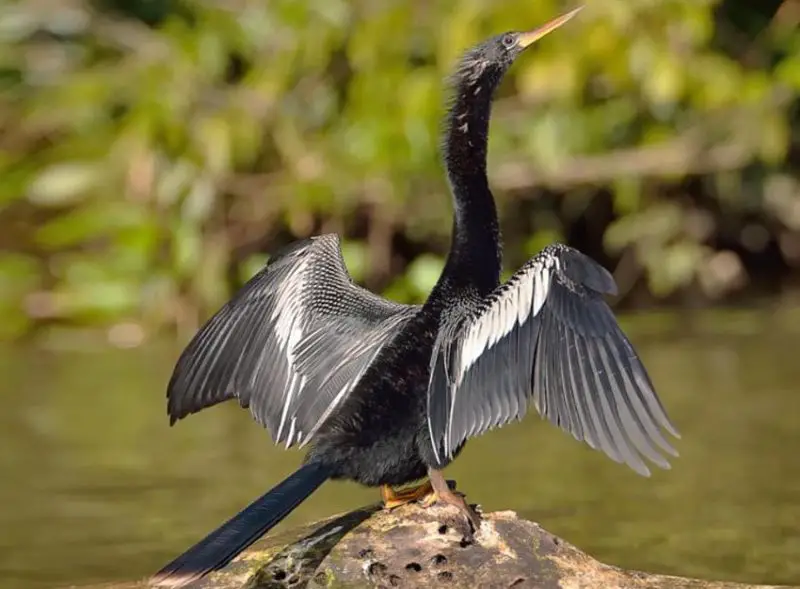
The Anhinga, also called the “snakebird,” has a slender, long neck and a pointed, dagger-like bill, giving it a distinctive silhouette. Its plumage is dark brownish-black with silvery streaks on the wings. Adults measure 30 to 35 inches long, with a wingspan of about 45 inches.
This bird is an expert underwater hunter, using its sharp bill to spear fish before swallowing them whole. It often swims with only its long neck exposed, resembling a snake moving through the water. Anhingas spend long periods perched with wings spread open to dry after diving.
In California, sightings are rare, but small populations are occasionally seen in freshwater marshes and lakes, particularly in Southern regions. They prefer warm, slow-moving waters surrounded by dense vegetation.
California Black Rail (Laterallus jamaicensis coturniculus)
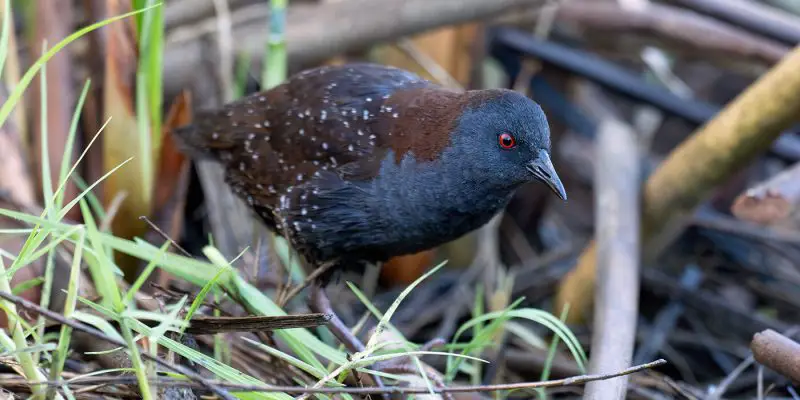
The California Black Rail is a secretive marsh bird with dark grayish-black plumage speckled with white spots. It has a short tail, reddish eyes, and a relatively long, thin bill suited for probing mud for insects and small invertebrates. Adults are small, measuring about 4 to 6 inches in length with a wingspan of only 9 inches.
This elusive species spends most of its life hidden in dense wetland vegetation, moving quietly among reeds and grasses. Its calls are a series of repetitive “kickee-doo” notes, which are often the only way to detect its presence. Black Rails are mostly active during dawn and dusk.
In California, they are found in freshwater and brackish marshes, especially in the San Francisco Bay and the Sierra Nevada foothills. Their populations are declining due to habitat loss, making them a species of conservation concern.
Double-crested Cormorant (Nannopterum auritum)
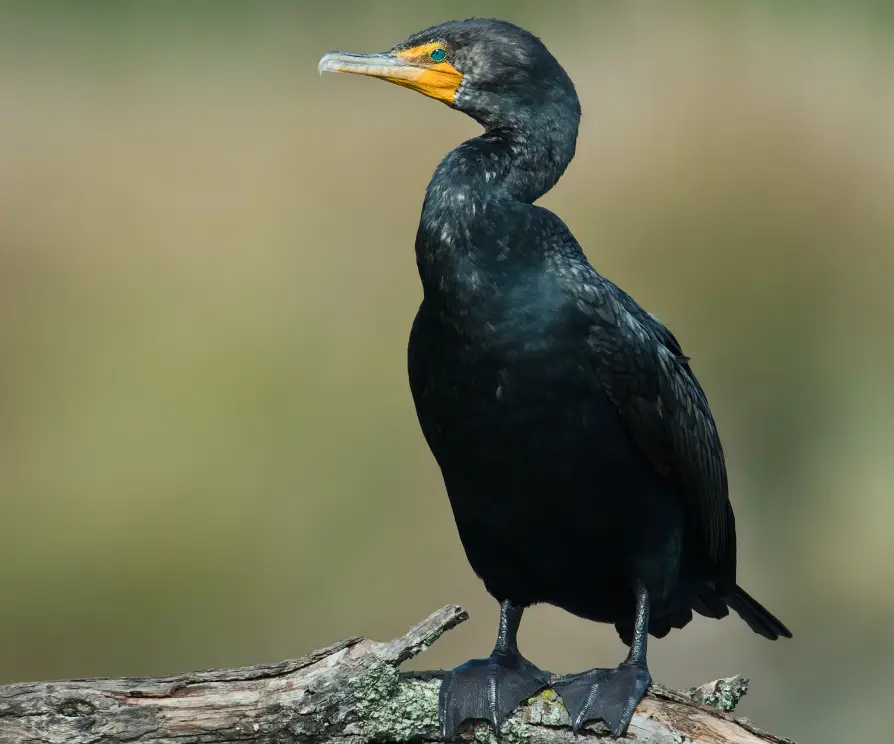
The Double-crested Cormorant is a large, dark waterbird with blackish-brown plumage, a long neck, and a slender hooked bill. During the breeding season, adults develop distinctive tufts of feathers, or “double crests,” on their heads. They average 27 to 35 inches long, with a wingspan of about 50 inches.
These birds are expert divers, using their webbed feet to propel themselves underwater while catching fish with their sharp bills. After fishing, they are often seen perched with wings spread to dry, as their feathers are not fully waterproof. Their vocalizations are mostly guttural grunts, especially in colonies.
In California, Double-crested Cormorants are widespread along coasts, lakes, and reservoirs. They nest in colonies on cliffs, trees, and islands, often sharing habitats with pelicans and gulls.
FAQs about Black Birds with Long Beaks in California
What are the most common black birds with long beaks in California?
Some of the most common black birds with long beaks in California include the Black Oystercatcher, Black Skimmer, Long-billed Curlew, and Great-tailed Grackle. These birds are frequently seen along coastlines, wetlands, and even urban areas.
Where can I find black birds with long beaks in California?
You can find these birds in various habitats, including rocky shorelines, tidal mudflats, estuaries, inland lakes, and even city parks. For example, Black Oystercatchers are common along rocky coastal areas, while Long-billed Curlews are often spotted in agricultural fields and marshes.
Do all black birds with long beaks live near the coast?
No, not all of them are coastal birds. While species like the Black Oystercatcher and Black Skimmer prefer coastal habitats, birds such as the Common Raven, Brewer’s Blackbird, and Brown-headed Cowbird thrive in inland regions, including grasslands and urban areas.
What do black birds with long beaks eat?
Their diet varies depending on the species. Shorebirds like the Long-billed Curlew and Marbled Godwit use their long beaks to probe for worms and crustaceans in mudflats, while Black Skimmers skim fish from the water’s surface. Ravens and grackles are opportunistic feeders, eating insects, seeds, and even human food scraps.
Are black birds with long beaks found year-round in California?
Some species, such as the Black Oystercatcher, Common Raven, and American Coot, are residents year-round. Others, including Whimbrels and Long-billed Curlews, are seasonal migrants that visit California mainly during winter.
Are any black birds with long beaks in California endangered?
Yes, some species are of conservation concern. The California Condor is critically endangered but has been reintroduced successfully in some regions. The California Black Rail also faces population declines due to habitat loss in wetlands.
Can I see black birds with long beaks in urban areas?
Yes, certain species adapt well to human environments. Brewer’s Blackbirds, Brown-headed Cowbirds, and Great-tailed Grackles are commonly seen in city parks, parking lots, and agricultural fields.

